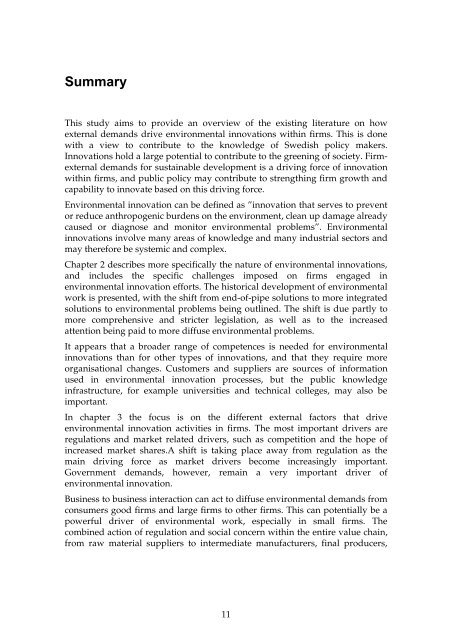Drivers of environmental innovation - Vinnova
Drivers of environmental innovation - Vinnova
Drivers of environmental innovation - Vinnova
You also want an ePaper? Increase the reach of your titles
YUMPU automatically turns print PDFs into web optimized ePapers that Google loves.
Summary<br />
This study aims to provide an overview <strong>of</strong> the existing literature on how<br />
external demands drive <strong>environmental</strong> <strong>innovation</strong>s within firms. This is done<br />
with a view to contribute to the knowledge <strong>of</strong> Swedish policy makers.<br />
Innovations hold a large potential to contribute to the greening <strong>of</strong> society. Firmexternal<br />
demands for sustainable development is a driving force <strong>of</strong> <strong>innovation</strong><br />
within firms, and public policy may contribute to strengthing firm growth and<br />
capability to innovate based on this driving force.<br />
Environmental <strong>innovation</strong> can be defined as ”<strong>innovation</strong> that serves to prevent<br />
or reduce anthropogenic burdens on the environment, clean up damage already<br />
caused or diagnose and monitor <strong>environmental</strong> problems”. Environmental<br />
<strong>innovation</strong>s involve many areas <strong>of</strong> knowledge and many industrial sectors and<br />
may therefore be systemic and complex.<br />
Chapter 2 describes more specifically the nature <strong>of</strong> <strong>environmental</strong> <strong>innovation</strong>s,<br />
and includes the specific challenges imposed on firms engaged in<br />
<strong>environmental</strong> <strong>innovation</strong> efforts. The historical development <strong>of</strong> <strong>environmental</strong><br />
work is presented, with the shift from end-<strong>of</strong>-pipe solutions to more integrated<br />
solutions to <strong>environmental</strong> problems being outlined. The shift is due partly to<br />
more comprehensive and stricter legislation, as well as to the increased<br />
attention being paid to more diffuse <strong>environmental</strong> problems.<br />
It appears that a broader range <strong>of</strong> competences is needed for <strong>environmental</strong><br />
<strong>innovation</strong>s than for other types <strong>of</strong> <strong>innovation</strong>s, and that they require more<br />
organisational changes. Customers and suppliers are sources <strong>of</strong> information<br />
used in <strong>environmental</strong> <strong>innovation</strong> processes, but the public knowledge<br />
infrastructure, for example universities and technical colleges, may also be<br />
important.<br />
In chapter 3 the focus is on the different external factors that drive<br />
<strong>environmental</strong> <strong>innovation</strong> activities in firms. The most important drivers are<br />
regulations and market related drivers, such as competition and the hope <strong>of</strong><br />
increased market shares.A shift is taking place away from regulation as the<br />
main driving force as market drivers become increasingly important.<br />
Government demands, however, remain a very important driver <strong>of</strong><br />
<strong>environmental</strong> <strong>innovation</strong>.<br />
Business to business interaction can act to diffuse <strong>environmental</strong> demands from<br />
consumers good firms and large firms to other firms. This can potentially be a<br />
powerful driver <strong>of</strong> <strong>environmental</strong> work, especially in small firms. The<br />
combined action <strong>of</strong> regulation and social concern within the entire value chain,<br />
from raw material suppliers to intermediate manufacturers, final producers,<br />
11

















